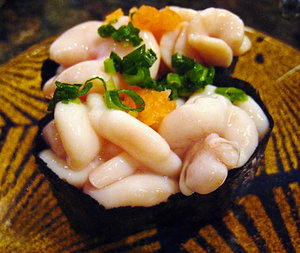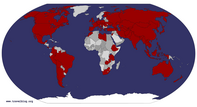COMING SOON HOUSE ADVERTISING ads_leader

 Shirako
Shirako
Does not look as bad as it tastes!I recently saw this list on MSN, and after tabbing through all of them, I soon realized I have tasted many of them. A few are rather gross, a few actually taste good, and a few leave me completely in awe of those culinary pioneers who have no limits as to how far they will go to enjoy the bounty of their environment.
1. Shirako (Japan)
I sincerely doubt if this is the national dish of Japan. But shirako is the male counterpart of fish roe, milt. Milt is not short for Milton Friedman, or Milton Berle. Milt is the sperm filled reproductive glands of male fish, usually cod, anglerfish or pufferfish. They say it has a creamy, custardy texture. The reason I doubt it is the national dish is that I have never seen it, whether in a restaurant in Japan, at the largest fresh fish market in the world (Tsukiji Fish Market), or Japanese grocery store.
2. Lutefisk (Scandinavia)
I grew up in the Swedish town of Kingsburg, where everyone was named Johnson or Olson, where every girl in my classroom was blue eyed and blonde, where it was easy to get good grades in

 Capybara
Capybara
Cute bot not too tastyschool because of all the dumb Swedish farm boys. Lutefisk is made from air dried or salted whitefish and lye. Lye is meant for use as a corrosive alkaline oven cleaner (Easy Off) or drain opener (Draino). The secret, obviously, is to soak or incubate the fish in the lye for the correct amount of time. The fats in the fish cannot turn to soap! The result is a jellylike consistency, and a dreadfully awful smell. As children, we were offered this dish when we visited some of our Swedish friends after school, and stayed for dinner. We often did not go back. We preferred to have them come over to our house. I imagine the Scandinavians did this to ensure having fish year around. Why the Swedes in our town would do this is a mystery to me. We had fresh fruit, vegetables, meat and fish available year around!
3. Kenke (Ghana)
Kenke is partially fermented and partially cooked corn meal. But first, ground corn is soaked in water and allowed to ferment for three days. The kernels are then partially cooked, wrapped in banana leaves, and steamed until they reach the consistency of mushy polenta. It

 Rambutan
Rambutan
Now this is great!is usually served with a stew of crushed tomatoes, and pepper. I will not try this on my upcoming trip to Africa. I pity the poor vegans on the trip.
4. Airag (Mongolia)
Airag, like beer in America, is mildly acidic, alcoholic drink from fermented mare's milk (I assume high in estrogen). During production, lactobacilli bacteria acidify the milk (yes the same lactobacillus used to make yogurt). Yeasts are added to carbonate and ferment the drink. In order to obtain the right consistency, the mix is stirred no less than 1000 times EVERY day. The final product is 18 proof, more than beer, but less than wine. I saw a similar product for sale in Nepal, but when I was informed of its smell, I ran back to Thailand!
5. Trung Vit Lon (Vietnam)
This is a fertilized duck egg with a nearly developed embryo inside. This aphrodisiac has counterparts in other countries, like the balut in the Philippines. The maturity of the egg depends on the region of the country. It is boiled and eaten in the shell. The broth is sipped from the egg before the shell is peeled. The unborn chick's bones are firm but tender. I saw a version of this is Laos, and could not bring myself to try it. I think someone who likes raw eggs and undercooked duck would enjoy this delicacy.
6. Capybara (Brazil and Peru)
We saw they strange looking creatures during our stay in the Amazon in Peru. This is a larger, meaner rodent than the guinea pig or cuy. Adults can grow up to four feet long and weigh 140 pounds. This slow moving and strange looking creature is easily caught. The meat is marinated in garlic, onions, pepper, bay leaf, and vinegar for five hours. It is served as a type of casserole. I suspect we must have been fed this at our jungle lodge, though we were probably told it was chicken or pork. Every morning we did a head count in front of our cabin just to make sure the family unit was intact.
7. Black Pudding (England)
Of course, we all know that black pudding is not pudding, but really a type of sausage. It is made by combining coagulated blood with a filler that may consist of meat, fat, oatmeal, and bread. This is cooked until it congeals when cooled. Traditional British and Scottish breakfasts have these vampiric tendencies, with a few slices served with eggs, baked beans, tomatoes, and mushrooms. Fortunately, we were introduced to this type of breakfast at a buffet, where we had control of the blood sausage potion. Turns out it was on a trip to Scotland, and our breakfast was held at the St Andrews Old Course Hotel.
8. Boshintang (Korea)
This is the most common dish containing dog meat. Specifically, it is a fellow dog that is raised specifically for this purpose, and not Fido from down the street. This popular dish is served at over 6000 restaurants in South Korea alone. The meat is boiled with green onion, dropwort, perilla leaves, and perilla seed powder. International animal rights groups are trying to abolish this practice. I agree. A friend, really a former employee of mine, had dog meat in China. He said it was very sweet.
9. Muktuk (Greenland)
The Inuits have been harpooning 3500 pound whales since the Ice Age. The dish is made from the raw skin and blubber, and is considered a delicacy. The textured layers are rubbery with hazel nut flavored skin, with chewy white fat in between the two thin corklike protective layers. I believe that Andrew Zimmern of Bizarre Foods on the Travel Channel ate very similar items on his trip to northern Alaska. I saw this at the grocery store in Anchorage, and did not buy it since I could not identify it at the time. Of course, later that day, the Loma Prieta earthquake his the Bay Area, and my nephew, Spencer was born.
10. Tacos de sesos (Mexico, Fresno)
Whoever said "the brain is a terrible thing to waste" did not know that Mexican cooks all over the Americas serve up tacos made from cow brains. This gray matter is very high in cholesterol. And according to most medical experts, mad cow disease (bovine spongiform encephalopathy) has an incubation period of fifty years. Brave this national and Central Valley dish at your own risk. The brains are also grilled in Argentina along with the other parts of beef. The taste is rather rich and creamy, but a good malbec washes it down with ease.
I have seen and tried some equally weird, ugly, awful tasting and downright gross things over the years. Here are a few:
1. Durian (Thailand, Laos, Malaysia)
This "King of Fruits" is popular in SE Asia, and a favorite of Sheri. I think it tates like a cross between rotten onions and stinky sweat socks. It is forbidden in all hotels in SE Asia.
2. Ox Testicles (anywhere)
The famous Asadachi, made famous by Andrew Zimmern of the Travel Channel, specializes in exotic and erotic body parts that nobody else wants. This was their daily special on the day of our visit. The chef said it would enhance my manhood, if you know what I mean!
3. Sea Cucumber (anywhere)
It is as ugly as it is briny and crunchy. Think of it as a salty version of your toes.
4. Uni (Bay Area)
Sea urchin is one of my favorite types of sushi. It is rich and custardy, with a hint of ocean. They actually still have an uni auction at the Tsukiji Fish Market in Tokyo, even though the sea urchin is from California!
5. Snake (Hong Kong)
Perhaps nowhere in the world can boast the range of specialty restaurants in Hong Kong. The sign outside said "Fresh Snake". Mike and I had to try it. The texture is much like a delicate white fish, but it picks up the flavor of whatever is cooked with it. We had it sauteed with garlic and greens. Not bad. It does not taste like chicken!
6. Cuy (Peru)
Everyone makes a big deal of eating guinea pig. It is just a greasy, gamey version of a pig. Barbecued is best, due to its fatty nature.
7. Emu (New Zealand)
Tastes like a very rich version of beef, with a nice texture. In fact, the kangaroo that we had was also a very lean, and tender meat, similar to beef as well.
8. Rambutan (SE Asia)
This lychee like fruit is covered with a reddish soft shell, that looks like a hairy testicle. It is best to open the soft shell with your teeth. The fruit inside is white, fairly firm and gelatinous, with a uniquely pleasant flavor. And oddly, they actually bear fruit twice a year! We bought some recently here in the Bay Area at County Square Market.
9. Flying Squirrel (Laos)
It is illegal to sell flying squirrel, even in Laos. But this animal was barbecued, and smelled really good. But when we walked by, the lady in her little stall quickly hid the bucket of barbecued squirrel. I guess she thought we were undercover agents for the Laotian Fish and Game Department.
10. Whale Sashimi (Japan)
Though rather pricey, we got to try some in Japan at the Tsukiji Fish Market. It takes like very tender beef. Was it legal? I assume it was or they would not sell it. A few gourmet places near Shibuya station specialize in whale only dishes. I doubt we were eating Moby.
COMING SOON HOUSE ADVERTISING ads_leader_blog_bottom
Tot: 0.058s; Tpl: 0.011s; cc: 13; qc: 29; dbt: 0.0269s; 1; m:domysql w:travelblog (10.17.0.13); sld: 1;
; mem: 1.1mb













deleted_49612
deleted_49612
I love eating those when I am in SE Asia. They are a luxury for Europeans. They cost a fortune here in Germany when they are possible to get at all. :)